Red light therapy boosts your natural collagen production by penetrating your skin's layers with specific wavelengths (630-850 nanometers) that activate your cells' mitochondria. This activation increases ATP energy production in your fibroblast cells, powering their ability to synthesize new collagen and elastin. The therapy's targeted wavelengths match collagen's natural absorption peaks, while near-infrared light reaches deeper tissue layers for enhanced repair. Your skin responds to this light stimulation by triggering multiple cellular pathways and enzymes essential for collagen formation. Understanding the science behind these precise wavelengths reveals even more fascinating benefits for your skin's health.
Red Light Therapy and Mitochondria
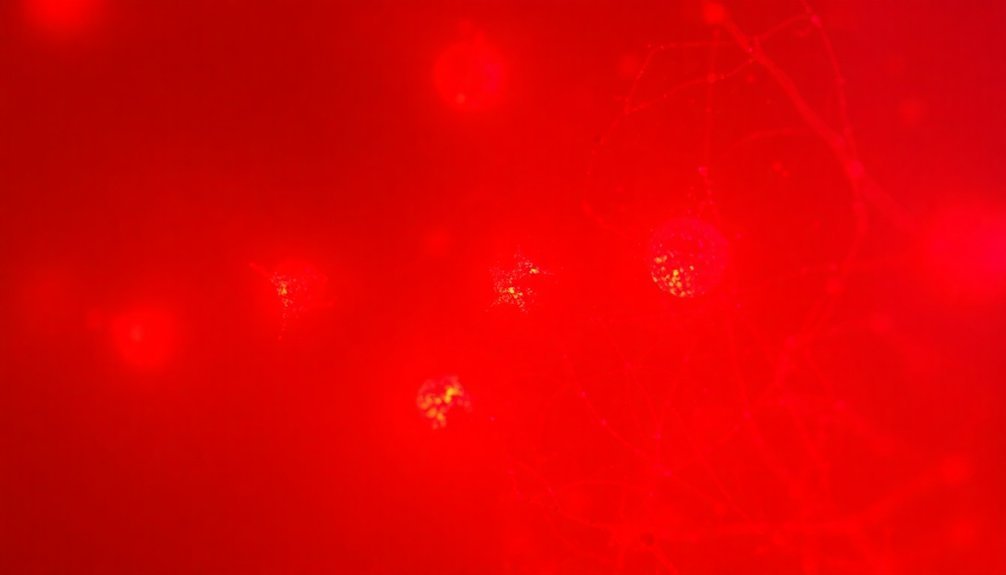
Nearly every cell in your body contains mitochondria, the powerhouse organelles that play a crucial role in Red Light Therapy's effectiveness. When you expose your skin to red and near-infrared light wavelengths, your mitochondria absorb this energy and convert it into ATP (adenosine triphosphate), the primary fuel source for cellular activities.
Your mitochondria become more efficient at energy production through this process, leading to enhanced cellular respiration. This boost in ATP production directly supports various cellular functions, particularly collagen synthesis. When your cells have more energy, they're better equipped to produce and maintain collagen, the protein responsible for skin elasticity and firmness.
The relationship between mitochondrial function and cellular health doesn't stop there. Red Light Therapy also helps reduce oxidative stress while supporting cellular regeneration processes. Your cells' ability to cleanse themselves improves, and the extracellular matrix becomes healthier. The therapy is especially effective since it operates at low levels of heat, making it completely safe and non-invasive for regular treatments.
This enhanced cellular environment creates favorable conditions for sustained collagen production. Through repeated exposure to Red Light Therapy, your mitochondria maintain higher efficiency levels, leading to continued improvements in cellular function and collagen synthesis.
Fibroblasts and Deep Skin Impact
Deep within your skin's layers, fibroblasts serve as the primary cellular architects responsible for collagen and elastin production. When you undergo red light therapy, these specialized cells receive targeted stimulation that enhances their natural production capabilities, particularly in the deeper dermis layers where significant skin rejuvenation occurs.
Your fibroblasts respond to red light therapy through multiple mechanisms. The treatment triggers increased gene expression related to collagen synthesis while boosting ATP production, which provides the necessary energy for enhanced fibroblast activity. Near infrared light causes fibroblasts to differentiate into myofibroblasts, further supporting collagen production.
When you combine red light with near-infrared wavelengths, you'll experience amplified elastin production, contributing to improved skin elasticity.
What makes this therapy particularly effective is its ability to penetrate deep into your skin layers non-invasively. Unlike some aggressive treatments, red light therapy stimulates your fibroblasts naturally, promoting collagen and elastin production without damaging surrounding tissues.
You can even combine this therapy with other treatments like Ultherapy or CO2 lasers to maximize collagen production across different skin depths. This multi-layered approach helps you achieve thorough skin rejuvenation, improving both texture and firmness through natural biological processes.
Wavelength Science
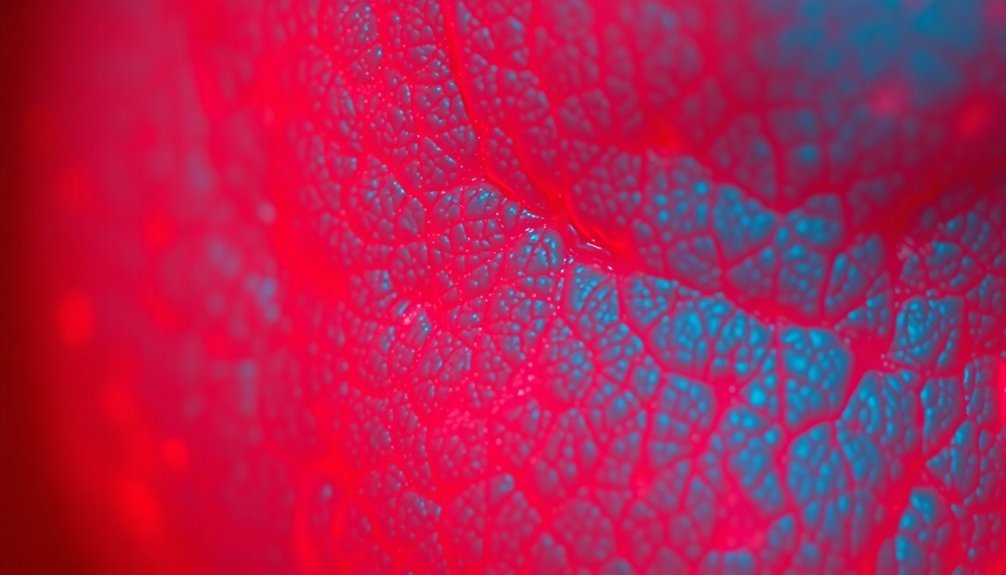
You'll find that different wavelengths of red light therapy penetrate the skin at varying depths, with near-infrared reaching the deepest layers where collagen-producing fibroblasts reside.
Red light wavelengths between 630-700 nm effectively target the dermis layer, where they're absorbed by cellular chromophores and stimulate collagen synthesis. This process triggers fibroblast activation which naturally increases the production of essential skin proteins.
The ideal absorption rate occurs when you combine specific wavelengths, such as 660 nm red light with 850 nm near-infrared light, creating a synergistic effect that maximizes collagen production throughout multiple skin layers.
Optimal Penetration Depths
Understanding wavelength penetration is crucial for effective red light therapy outcomes. The depth that light reaches directly impacts its ability to stimulate collagen production in your skin's layers. While red light (630-680 nm) penetrates 1-2 mm deep, near-infrared light (780-980 nm) reaches slightly deeper at 2 mm with 63% intensity. Red light wavelengths can deliver therapeutic rejuvenation benefits when properly applied to the skin.
| Wavelength | Penetration Depth | Typical Use |
|---|---|---|
| 633 nm | 1.8 mm | Surface wrinkles |
| 660 nm | 2.0 mm | Collagen stimulation |
| 850 nm | 2.4 mm | Deep tissue repair |
Your skin's thickness, pigmentation, and hydration levels will affect how deeply the light penetrates. To maximize penetration, you'll want to evaluate both wavelength and intensity. Higher-powered devices can reach deeper tissues, though you'll need substantially more power for minimal depth increases. Using pulsed light can also improve penetration by reducing tissue heating.
For the best collagen production, you'll need light that reaches your dermis and subcutaneous layers where fibroblasts are active. While some studies suggest deeper penetration is possible (660 nm reaching 21 mm), practical applications typically focus on the 1-2 mm range where most collagen-producing cells reside.
Light Energy Absorption Rates
Three key mechanisms drive light energy absorption in red light therapy: cellular respiration, mitochondrial activation, and fibroblast stimulation. When you're exposed to red and near-infrared wavelengths between 600-1100 nm, your cells begin absorbing this specific light energy, triggering a cascade of biological responses.
Your skin's absorption rates vary depending on the wavelength used. The 585 nm wavelength specifically targets hemoglobin, boosting procollagen production, while near-infrared wavelengths (1100-1700 nm) match collagen's natural absorption peaks.
You'll get the most effective results when the light source matches these specific wavelengths, as broadband light sources don't achieve the same absorption rates.
When your cells absorb the right wavelengths, your mitochondria respond by increasing ATP production. This enhanced energy production directly powers your fibroblasts, the cells responsible for creating new collagen.
The absorption process is precise – different wavelengths target specific tissue components like oxyhemoglobin, water, and collagen. This targeted approach explains why red light therapy's absorption rates make it so effective at stimulating natural collagen production compared to other treatments.
Natural Collagen Production Process
Your skin's natural collagen production starts with cellular energy activation in fibroblast cells, where mitochondria power the complex synthesis process.
These specialized cells respond to various stimuli through specific molecular pathways, triggering the intricate steps of collagen formation from amino acid assembly to triple helix creation.
The fibroblast stimulation pathways involve multiple enzymes and co-factors, including vitamin C and copper, which work together to facilitate the complete collagen synthesis cycle from intracellular production to extracellular assembly.
Cellular Energy Activation Mechanisms
Through the intricate process of cellular energy activation, your body's fibroblasts work to produce collagen naturally. When you expose your skin to red and near-infrared light therapy, it stimulates your mitochondria – the cellular powerhouses that convert light, oxygen, and nutrients into usable energy in the form of ATP.
This boost in cellular energy triggers important signaling pathways within your fibroblasts. Your cells' Piezo1 channels help mobilize calcium, which activates the TGF-β pathway that's essential for collagen synthesis.
The ERK1/2/AKT pathways also come into play, supporting cell proliferation and collagen production.
Your body's collagen synthesis depends on maintaining the right balance of cellular signals. Growth factors like bFGF and IGF-1 stimulate procollagen synthesis, while mechanical load influences how your fibroblasts produce collagen.
The enhanced mitochondrial function from red light therapy provides the necessary energy for these processes to work efficiently. As your cells receive this energy boost, they're able to create more collagen naturally, supporting improved skin, bone, and joint health through these cellular mechanisms.
Fibroblast Stimulation Pathways
Natural collagen production relies on multiple fibroblast stimulation pathways working in harmony. When your fibroblasts receive mechanical tension and proper stimulation, they activate several key signaling pathways, including ERK, AKT, and STAT1. These pathways work together to trigger collagen synthesis and cellular proliferation.
FGF2 plays an essential role by stimulating your fibroblasts to produce more collagen, while TGFB1 enhances both collagen production and matrix contractility.
Your cells need sufficient ATP energy to power these processes, which is where red light therapy comes in – it boosts mitochondrial energy production and activates specific genes responsible for collagen synthesis.
The process requires essential nutrients like glycine, proline, and lysine, along with vitamin C as a critical cofactor for hydroxylase enzymes. Inside your cells, collagen synthesis involves complex post-translational modifications in the endoplasmic reticulum, where three pro-alpha chains form a triple helix structure.
After propeptide cleavage, lysyl oxidase helps create strong bonds between tropocollagen molecules, forming the collagen fibrils that make up your extracellular matrix.
This coordinated cellular dance results in healthy collagen production when all pathways function effectively.
Research-Backed Anti-Aging Results
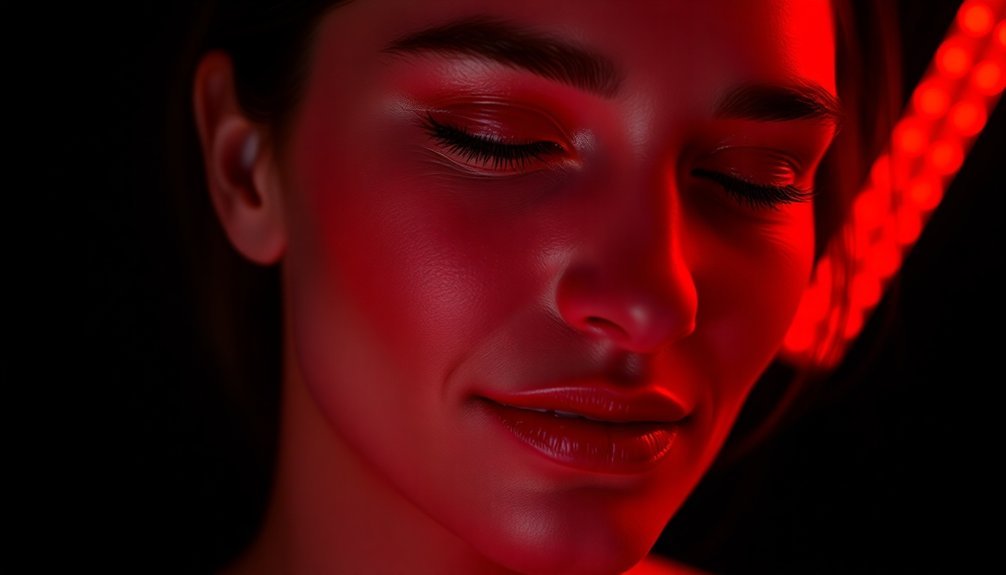
Scientific research has backed up red light therapy's impressive anti-aging capabilities, particularly in boosting collagen production and skin rejuvenation. Clinical studies have shown significant increases in collagen density following treatments, leading to reduced wrinkles and improved skin texture.
This therapy works by stimulating your skin's natural collagen-producing mechanisms without any adverse effects.
The evidence demonstrates that red light therapy penetrates deep into your dermis, where it activates fibroblasts and increases procollagen type I production. When you undergo treatment, the light wavelengths, particularly at 635 nm and 830 nm, enhance your mitochondrial function and ATP production, providing the energy needed for ideal collagen synthesis.
You'll see measurable improvements in skin firmness and elasticity with consistent use, as the therapy effectively reduces matrix metalloproteinases that break down collagen.
What's particularly significant is that these benefits aren't temporary – studies confirm long-term efficacy with continued treatment. Whether you're using professional equipment or home devices, the research supports red light therapy's ability to naturally boost your collagen levels and deliver visible anti-aging results.
Clinical Applications and Benefits
Based on extensive clinical research, red light therapy demonstrates remarkable versatility in treating various skin and musculoskeletal conditions. You'll find that its therapeutic benefits extend far beyond basic skin care, offering a thorough approach to health and wellness through its ability to stimulate natural collagen production and cellular repair.
| Condition | Clinical Benefit |
|---|---|
| Acne & Rosacea | Reduces inflammation and redness while promoting healing |
| Wound Healing | Accelerates tissue repair and minimizes scarring |
| Joint Pain | Decreases inflammation and provides natural pain relief |
| Skin Aging | Boosts collagen production and improves elasticity |
| Sleep Quality | Enhances melatonin production and regulates circadian rhythm |
When you undergo red light therapy, you're activating multiple healing mechanisms simultaneously. The treatment stimulates your mitochondria to produce more ATP, energizing your cells for peak function. You'll experience improved blood circulation, which delivers essential nutrients to your skin cells and promotes detoxification. The therapy also reduces oxidative stress while triggering beneficial gene expression related to collagen production. These combined effects make red light therapy an effective solution for both aesthetic and therapeutic applications, supported by measurable clinical outcomes.
Frequently Asked Questions
How Long Should Each Red Light Therapy Session Last for Optimal Results?
You'll get best results with red light therapy sessions lasting 15-30 minutes. Plan on twice-weekly treatments, and don't exceed recommended times. Consistency matters more than duration for achieving your desired outcomes.
Can Red Light Therapy Be Combined With Other Skincare Treatments?
Yes, you can combine red light therapy with other skincare treatments. Just be sure to layer products properly and time your treatments wisely, especially with retinol. Use complementary ingredients like peptides and Vitamin C.
Are There Any Side Effects From Using Red Light Therapy Regularly?
You'll find red light therapy is generally safe, but prolonged exposure can cause skin damage. Watch for burns, blisters, or eye issues if misused. Always follow treatment guidelines and monitor your skin's response.
What's the Recommended Distance Between the Device and Skin During Treatment?
You'll want to keep your device 6-12 inches away from your skin during treatment. This ideal distance guarantees safety and effectiveness. Always check your device's manual, as specific recommendations may vary.
How Often Should Red Light Therapy Treatments Be Done Each Week?
You'll need 3-4 sessions weekly during the initial phase for the best collagen boost. Once you've achieved desired results, scale back to 1-2 maintenance sessions per week to sustain your skin's improvements.
In Summary
You've now learned how red therapy's specific wavelengths penetrate your skin to energize cellular mitochondria and activate fibroblasts, triggering your body's natural collagen production. By exposing your skin to these therapeutic red and near-infrared wavelengths, you're supporting your cells' ability to create more collagen, leading to improved skin texture and reduced signs of aging. For best results, you'll want to maintain consistent treatment sessions.
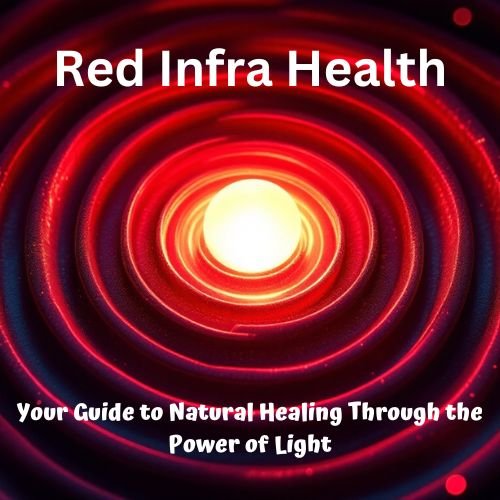



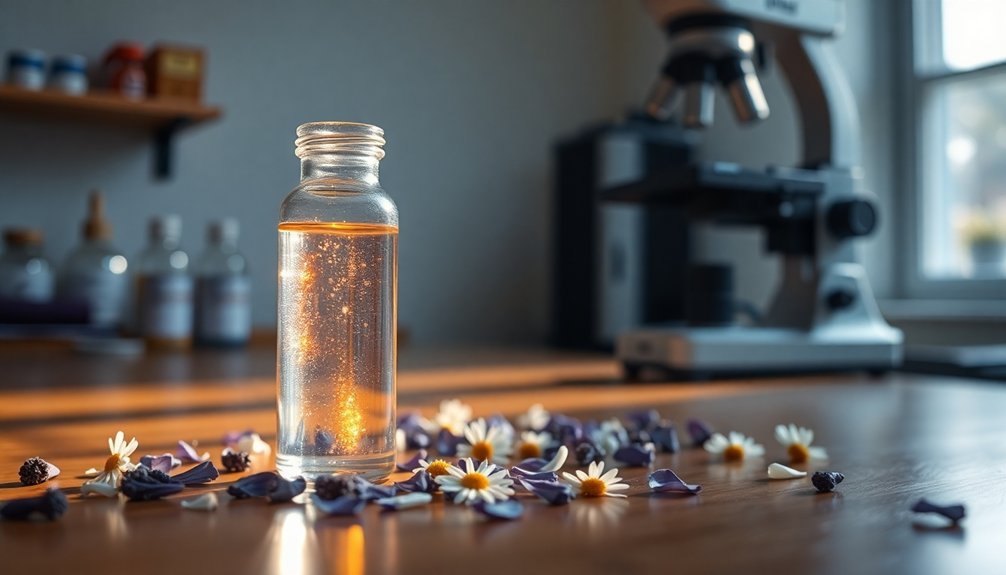
Leave a Reply